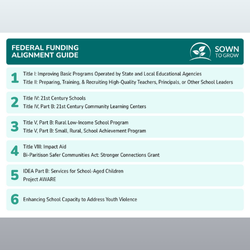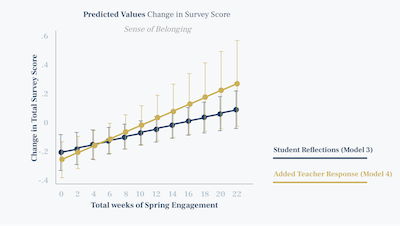How Sown To Grow measures & supports student-teacher connection

.png)
Trusting student-teacher relationships create a solid foundation for student academic success and sense of belonging at school. As educators, we know this in our hearts and because the research supports it. And at Sown To Grow, we believe in using technology to enhance, not replace, this vital connection, so that we can empower educators to best support their students.
Many teachers have shared how our emotional check-ins tools have enabled them to connect with their students in new ways. Backed by a National Science Foundation Small Business Innovation Research grant, Sown To Grow set out to more deeply understand this process, evaluate and measure the change we see in student-teacher connection on our platform, and ultimately provide scaffolds for teachers and admins to support further connection growth.
I feel like students really open up and share vulnerably the things they are experiencing. It allows me to better know students as a teacher, and to bring in other professionals when needed. - Teacher, Pajaro Valley Unified School District
"[Sown To Grow] really helps to break the ice with students while also helping to build a great student-teacher relationship." - Teacher, Mountain Empire Unified School District
Our Process
In order to better understand student and teacher connection, we started by creating measures to evaluate the ways in which students and teachers interact on Sown To Grow. Our emotional check-in protocol allows students to reflect on their week and respond to a prompt. Their teacher can then respond to the reflection. We have found this two-way communications to be essential for students to build trust and continue authentically reflecting.

To further understand and support the importance of these interactions, our team:
- Developed rubrics for categorizing student reflections
- Created a corresponding progression for categorizing how teachers respond
With these frameworks, we will soon be able to measure student-teacher connection and monitor how student-teacher relationships change over time. This information will allow Sown To Grow to better support teachers in responding to different types of student reflections with care.
In this post, we’ll share our learnings from steps 1 and 2 that we’ve developed through investigating pedagogical research, extensive review of anonymized student-teacher interactions, and conversations with field experts.
Student Reflection Rubric
In order to support student-teacher connection, we must first have a way to comprehensively understand the reflections students share with their teachers. After extensive research, we decided to categorize student reflections on two domains: reflective depth and self-disclosure. In other words, how deep a student's thinking goes, and how open they are with the information they share.
Our team chose to keep these two qualities separate to help us understand different areas. For example, we might encourage students to reflect more deeply, but they shouldn't feel pressured to share more personal details.
Reflective Depth
The scale of reflective depth focuses on how a student explores the content they shared. This measure assesses how deeply the writer thinks about and processes their experiences and emotions through their reflection.

Self-Disclosure
The scale for self-disclosure focuses on what is shared, specifically on the content and level of personal detail shared. As a student chooses to disclose more about themselves and their experiences, their teacher is able to build a clearer picture of the student’s complete person.

Combining these two domains of student reflection, we can get a more holistic picture of the way that students may share with their teachers. The range of student reflections can vary widely and does not fall on a strictly linear continuum. For example a student may share something vulnerable, but remain descriptive in how they share it. Likewise, a student may be highly reflective about a surface detail they choose to share.

A (Surface-Descriptive): “Today after school I am going to my grandma’s house to do an art project. And then going to sleepover at her house.”
B (Vulnerable-Descriptive): "My parents got divorced."
C (Vulnerable-Reflective): “I have no best friends to play with at recess and lunch…I loved third grade so much. I miss being with my friends and wished that they would be in the same class as me. Arham also insulted my height. Every day I look in the mirror and my height looks fine. I feel so stupid for being short and the way I am. What I am trying to try next week would be trying to stretch myself until I become taller then everybody. I cried all night and refused to eat or drink.”
No one way of reflecting is better than another. It is not the objective for students to be reflective and vulnerable each time they share with their teachers. But it is important to understand the difference between types of student expressions, so that teachers can appropriately respond, which is where we turned next.
Teacher Response Progression
Our teacher response progression is rooted in the same foundational framework as the teacher feedback suggestions that are offered on Sown To Grow. The platform provides teachers suggestions advising how to respond to students that either acknowledge what the student is sharing, affirm and validate the student’s feelings and experiences, or invite the student to share more.
After reviewing hundreds of anonymized teacher responses, we noticed similar patterns in how teachers were organically responding to students as well as new categories of responses that went a step deeper to provide highly personalized or strategic replies to students depending on the needs of a particular individual in a given week.
These insights led to our newly developed teacher response progression:


The progression from acknowledgement to closeness in teacher responses is not about one being better than another, but rather about recognizing the different roles each type of response plays in student engagement.
Similarly, a deeply reflective student response is not inherently more valuable than a surface-level descriptive one—both contribute to a diverse and dynamic exchange. The richness comes from the interplay between these different kinds of reflections and responses, as they create opportunities for connection, growth, and varied forms of support that meet students where they are in their individual learning and emotional journeys.
What’s next?
Our original intent of developing these individual measures for student reflections and teacher responses was to further our understanding of student-teacher connection growth for schools using Sown To Grow. However, as we built them out, we realized there are several other exciting applications of these frameworks to improve the experiences of students, teachers, and school leaders. For example, we can guide students to deeper reflective practice and understanding of their own emotions and well-being, as well as help identify those who might need support and connect them with the right adults in the building.
Receiving the ‘Authentic Student Reflections’ emails? Here’s what to know:
This work is powered by machine learning, which means it may not always be perfectly accurate. While we work to continuously improve its performance and accuracy, there will be some ‘grows’ (and ‘glows’) along the way. As a trusted partner, your input is welcome and valued by our team, so please feel free to send any issues or feedback on this feature to alwaysgrowing@sowntogrow.com.
We look forward to lots of exciting developments on this front in the months to come - stay tuned for updates!
—
🌱 Interested in learning more? Click below to connect! 🌱




.png)
.png)
.png)







